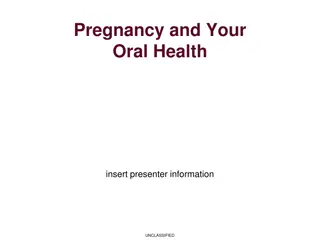Understanding Breech Presentation in Pregnancy
Breech presentation in pregnancy occurs when the baby is positioned buttocks or feet first instead of head first, which can complicate delivery and increase risks of perinatal mortality and morbidity. This article covers the types of breech presentation, symptoms, causes, diagnosis, management, and implications for delivery.
Download Presentation

Please find below an Image/Link to download the presentation.
The content on the website is provided AS IS for your information and personal use only. It may not be sold, licensed, or shared on other websites without obtaining consent from the author. Download presentation by click this link. If you encounter any issues during the download, it is possible that the publisher has removed the file from their server.
E N D
Presentation Transcript
StudyMafia.Org Breech Presentation Submitted To: Studymafia.org Submitted By: Studymafia.org
Table of Content What is Breech Presentation? How common is a Breech Presentation? Types of Breech Presentation Symptoms Causes Etiology and Risk Factors Diagnosis Management Conclusion References
What is Breech Presentation A breech presentation is when the fetus presents buttocks or feet first (rather than head first a cephalic presentation). It has significant implications in terms of delivery especially if it occurs at term (>37 weeks). Breech deliveries carry a higher perinatal mortality and morbidity, largely due to birth asphyxia/trauma, prematurity and an increased incidence of congenital malformations.
How common is a Breech Presentation? There is a small chance that your baby will not move into a head-first position before 37 weeks of pregnancy. Breech babies account for about 3% to 4% of all full-term pregnancies.
Types of Breech Presentation Frank breech: The baby s buttocks are aimed at the vaginal canal with its legs sticking straight up in front of their body and the feet near their head.
Types of Breech Presentation Complete breech: The baby s buttocks are pointing downward and both the hips and the knees are flexed (folded under themselves).
Types of Breech Presentation Footling breech: One or both of the baby s feet point downward and will deliver before the rest of their body.
Types of Breech Presentation Transverse lie: This is a form of breech presentation where your baby is positioned horizontally across your uterus instead of vertically. This would make their shoulder enter the vagina first.
Symptoms You may be able to tell if your baby is breech, especially if you have had past pregnancies where your baby was head-first. The places where you feel lumps and kicks might indicate that your baby is breech. Let your healthcare provider know where you feel movement. They will feel your belly or do an ultrasound to confirm that your baby is breech.
Causes It s not always known why a baby is breech. Some factors that may contribute to this position are: You are expecting multiples (twins or more). This makes it harder for each baby to get into the right position. There is too much or too little amniotic fluid. The placenta covers all or part of the cervix (a condition called placenta previa).
Causes The uterus is not normal in shape or has abnormal growths such as fibroids. Most of the time, the uterus is shaped like an upside-down pear. If it's shaped differently, there might not be enough room for a full- grown baby to move into position. The baby is preterm. This means they are less than 37 weeks gestation and may not have turned to a head- first position. Your baby has a birth defect that causes them to not turn head-down.
Etiology and Risk Factors Uterine Fetal Prematurity Macrosomia Polyhydramnios (raised amniotic fluid index) Twin pregnancy (or higher order) Abnormality (e.g. anencephaly) Multiparity Uterine malformations (e.g. septate uterus) Fibroids Placenta praevia
Diagnosis and Tests How is a breech baby diagnosed? Your healthcare provider may be able to tell which way your baby is facing by placing their hands at certain places on your abdomen. By feeling where the baby s head, back and buttocks are, it s usually possible to find out what part of the baby is positioned to come out of the vagina first. An ultrasound may be used to confirm the baby s position.
Diagnosis and Tests When is a breech baby diagnosed? Almost all babies are breech at some point. As your pregnancy progresses, your baby will naturally move to a head-down position probably between 32 and 36 weeks. Your healthcare provider will feel your belly and determine where your baby is positioned. This will happen during most of your appointments in the third trimester. After 37 weeks, a breech baby usually does not turn on their own. Your healthcare provider will discuss delivery options with you.
Management Practice points Offer ECV if there are no contraindications. If ECV is declined or unsuccessful, provide counselling on risks and benefits of a planned vaginal birth versus an ELCS. Inform the woman that there are fewer maternal complications with a successful vaginal birth, however the risk to the woman increases significantly if there is a need for an EMCS. Inform the woman that caesarean section increases the risk of complication in future pregnancies, including the risk of a repeat caesarean section and the risk of invasive placentation. If the woman chooses an ELCS, document consent and organise booking for 39 weeks gestation.
Management Information and decision making Good communication between clinicians and women is essential. Treatment, care and information provided should: take into account women's individual needs and preferences be supported by evidence-based, written information tailored to the needs of the individual woman be culturally appropriate be accessible to women, their partners, support people and families take into account any specific needs, such as physical or cognitive disabilities or limitations to their ability to understand spoken or written English.
Management Documentation The following should be documented in the woman's hospital medical record and (where applicable) in her hand-held medical record: discussion of risks and benefits of vaginal breech birth and ELCS discussion of the woman's questions about planned vaginal breech birth and ELCS discussion of ECV, if applicable consultation, referral and escalation
Management At term, the options for management of breech presentation are (i) external cephalic version; (ii) Caesarean section; (iii) vaginal breech birth.
Conclusion: Management of breech presentation with a protocol that includes ECV, careful selection criteria and active management of vaginal delivery achieve a great decrease in the rate of CS for breech presentation.
References Google.com Wikipedia.org Studymafia.org Slidespanda.com
Thanks To StudyMafia.org























